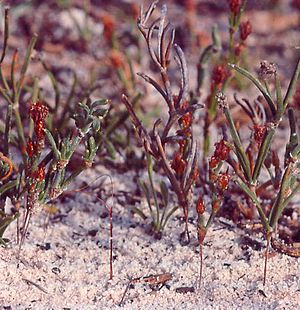Alexgeorgea facts for kids
Quick facts for kids Alexgeorgea |
|
|---|---|
 |
|
| Male Alexgeorgea flowers are in the background while only the three stigmas of a female flower are above ground. | |
| Scientific classification |
|
| Kingdom: | Plantae |
| Clade: | Tracheophytes |
| Clade: | Angiosperms |
| Clade: | Monocots |
| Clade: | Commelinids |
| Order: | Poales |
| Family: | Restionaceae |
| Genus: | Alexgeorgea Carlquist |
| Species | |
|
|
Alexgeorgea is a group of three special plant species. You can find them in Western Australia. These plants belong to a family called Restionaceae. They were named in 1976 after a botanist named Alex George.
What makes these plants unique? Their female flowers and large, nut-like fruits grow completely underground! Only tiny parts, called stigmas, poke out of the ground. These stigmas look like three purple or red threads.
Contents
How Alexgeorgea Was Discovered
Finding a Hidden Plant
The Alexgeorgea plant was first found by a botanist named Sherwin Carlquist. He discovered it on September 2, 1974. He was exploring near Jurien Bay in Western Australia.
At first, Carlquist only saw the male plants. He knew right away they were part of the Restionaceae family. To fully identify a plant in this family, you need both male and female flowers. So, he kept looking.
The Purple Threads
That's when he noticed something amazing. He saw "purple thread-like structures emerging from the sand." These were the tiny styles of the female flowers. The female flowers themselves were mostly hidden underground.
Carlquist later wrote about his discovery in a science journal in 1976. He said he might never have found the plant if he hadn't seen these short-lived purple threads. They only appear for a short time when the flowers are ready to be pollinated.
Naming the Species
The First Two Species
When Carlquist first described the genus, he named two species. They were A. subterranea and A. arenicola. The name arenicola means "a dweller on sand."
Adding a Third Species
About ten years later, in 1986, two Australian botanists, Lawrence Alexander Sidney Johnson and Barbara G. Briggs, added a third species. They worked at the Royal Botanic Gardens, Sydney. They realized that a plant previously called Restio nitens actually fit better with the Alexgeorgea group.
Restio nitens was first described in 1848. It was thought to have fruits that opened above ground. But Alexgeorgea plants have underground flowers and fruits. Carlquist had noticed that R. nitens and his A. arenicola looked very similar otherwise.
Johnson looked closely at old plant samples of R. nitens. He found that the fruits thought to be above ground were actually misshapen. They might have been affected by a type of fungus.
The Final Names
Both Johnson & Briggs and Carlquist independently decided to move R. nitens into the Alexgeorgea group. Carlquist then realized that A. arenicola was the same as the older name A. nitens. The older name always gets priority.
Johnson and Briggs published their new name, A. nitens, on April 24. Carlquist published his version just five days later. Because Johnson and Briggs published first, their naming is the official one.
The third species, A. ganopoda, was described by Johnson and Briggs in 1990. So now, there are three known species of Alexgeorgea.
See also
 In Spanish: Alexgeorgea para niños
In Spanish: Alexgeorgea para niños

